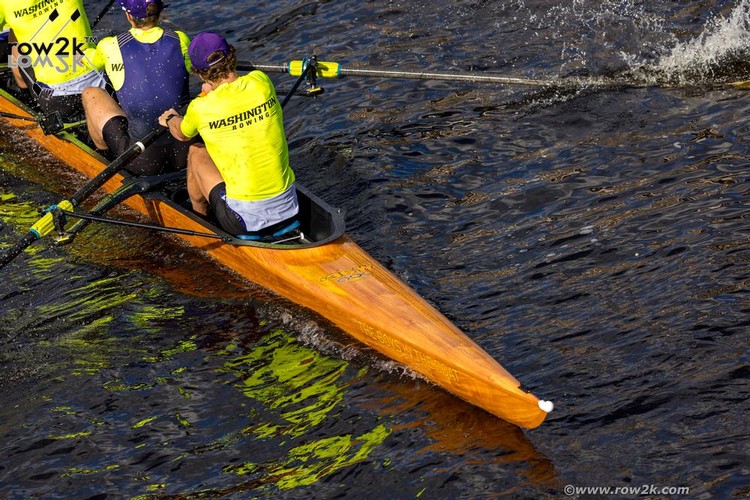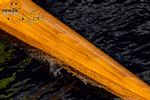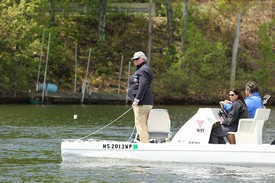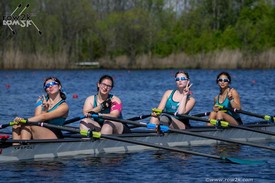John FX Flynn, row2k

Part II of our deep dive with WinTech's Dave Dickison, Brent Keuch, and Terry O’Neill on the story behind their contributions to the boats used in "The Boys in the Boat" movie.
Once WinTech had demonstrated that the sublimated fabric "veneer" would work--as we explored in Part 1--and the order for the ten shells rowed in the film was placed, the company became involved behind the scenes of the production as well, particularly O'Neill.
Being based in the UK where the filming took place, O'Neill found himself fully immersed in the project once the decision was made to shoot the film in Britain. He was eventually on set, in his words, "anytime anyone was on the water."
That all started after O'Neill fielded the producers' relatively simple request to redirect the container coming from China with the shells from American to England for the filming, and he was soon tasked with everything from transporting the shells between locations to sourcing the wooden oars. In the end, O'Neill--whose career includes coaching GB athletes at the 1988, 1992, and 1996 Games--even wound up coaching the actors, who were new to the sport, and the experienced rowers working as stand-ins on the film.
The coaching started with a two month training camp at Radley School before filming began--"It would not have been possible to have got those actors to that level without the help from Radley," according to O'Neill--and even included a trip to nearby Oxford so the actors could watch the Torpids bumps races and get a sense of what a regatta atmosphere might look like.

Meanwhile, O'Neill was busy finding a way to get enough wooden oars made to get all of the shells they'd made out on the water; the production needed eighty in all.
"The most difficult thing for me was getting the oars because they're handmade and the spoons are hand shaped. It takes a long time."
Originally, O'Neill had arranged for the oars to be made by Jerry Sutton, an old friend and long-time traditional oar-maker, but the filming schedule and the size of the order meant that Sutton needed help. Eventually, O'Neill was able to make a deal with a second company, Collars, to help finish the order, and the premium charged to get them finished in time might make the oars in the film the most expensive wooden blades ever made.
Getting the boats themselves fully ready to be on camera involved some more help from the WinTech engineers, David Thomas and Ed Hofmeister. Dave Dickison described how their contributions went beyond scanning the 1937 Pocock they used as a model. "They were pulled into the conversation and asked complex questions about brass oarlock creation & availability, 90 year old seat construction, and specific wood grain colors used by Pocock in the 1930’s."
Getting down to specific details like the wood grain would go on to play a role in the film, differentiating Washington's Pocock hull from the other shells in the Olympic final.
"The boats had to look different," Brent Keuch said, "because in 1936 [at the Olympics], there was only one Pocock."
"In the final, you had the Italians using the Donoratico, the Germans were using a Pirsch, the British were using the Sims," according to O’Neill. "With all of those, there wasn't that much obvious difference, but what was very different was that the gunnel on the Pocock used a very light colored pine. So the boat was two-tone and it was quite distinct, whereas the other boats would be stain varnished all the way over in one color."

In fact, there was another difference amongst the boats WinTech supplied, said Keuch: half were made in the King mold and the other half in the WinTech mold. Using two hull shapes also helps differentiate the boats a bit in the film, and making use of both molds allowed the company to turn around the full order of ten shells on a tight timetable.
The shells were also "dressed" by the film's art department with paint and detailing to heighten the effect created by the simulated wood sublimation.
"The attention to detail of the art director, Kalina Ivanov, was impressive," said Keuch. "They hand-painted 'Don't Step Here' in the bottom of the hulls and painted the little nail heads [along the hull] so it looks as if you are really looking at a wooden boat."
Fitting out the boats went beyond the sublimations, wooden interior details, and the painting: WinTech also supplied period-appropriate riggers and brass oarlocks, or swivels.
The authentic looking riggers, though, had "no adjustment whatsoever," said O’Neill, which prompted him to go to the film's director George Clooney when he realized he would need to order new riggers, specific to some of the actors in the crew, to get all the angles to match up. Clooney grasped the rigging dilemma, and told O’Neill to get it done.

"Every time I spoke to [Clooney] about anything technical, he understood," said O’Neill, who remembers asking him, "George, did you ever row? He said no. And I said, because you get what I'm talking to you about, and some of these things are really technical. And he said, I want to make a film where people that know about the sport can believe it. I really want to make a film that's believable when people see these guys rowing and get an idea of how hard it is."
The brass oarlocks were another feature they had to get correct to make the boats look right on screen.
"The European and the Pocock swivels were different" said O’Neill. "So we had to make two types of swivel. One was exactly the same as a 1936 European swivel, and the other one was a Pocock swivel.
Making them out of brass--which, of course, is what they look like they were made of and which films well-- actually turned out to be a problem, said O’Neill.
"They looked like brass," he said, "but in reality [the oarlocks] were gunmetal. You take an original gunmetal swivel, it is virtually indestructible. Brass isn't, and so we were getting a lot of breakages with these brass gates."

One place where they went through the brass gates "like no one's business" in O’Neill's retelling, was in the massive simulator rig that the effects department built for close-ups.
"The simulator was a complete rowing eight on a rig that moved up and down. They put the green screen behind it and they built a platform that the camera went along, so those close-up shots of the rowers, that's in that simulator and the rig that they made was fantastic."
Initially, however, the effects crew had set up the simulator's eight and its oars with wires to help it roll on the rails underneath the rig, but the wires ran counter to the way a shell actually moves--and that added resistance was too much load on the riggers and soft brass oarlocks.
On O’Neill's suggestion--as a rowing coach--that the mass of the moving bodies in the shell would be enough to move the rig without the wires, they disconnected the cables, which spared the riggers. Then, with some bungees added to the oars to provide just the right bit of resistance, thanks to another O’Neill tip, the crew in the simulator could easily and believably get up to the 46 strokes a minute needed for the scene of the final sprint at the Olympics without breaking anything.
After the filming wrapped, it turned out that O’Neill had one final task to complete: finding new homes for some of the boats built for the film.
Of the WinTech-built eights, one wound up at Lea Rowing Club and another went to a college at Oxford, so it is possible that one might come across a few of these eights out on the UK regatta circuit. The originally prototype that had been shipped to America and tested at Yale before going over the UK for use as a background prop wound up at a local club, according to O’Neill, where it is being used, appropriately enough, to teach people how to row.
"The Boys in the Boat" opens in theaters on December 25th.
Read Part 1 of this feature here.

If you enjoy and rely on row2k, we need your help to be able to keep doing all this. Though row2k sometimes looks like a big, outside-funded operation, it mainly runs on enthusiasm and grit. Help us keep it coming, thank you! Learn more.
Comments | Log in to comment |
- Bont Rowing
- Calm Waters Rowing
- Concept 2
- Craftsbury Sculling
- The Crew Classic
- CrewLAB
- Croker
- Dad Vail Regatta
- Durham Boat Co.
- Empacher
- Faster Masters
- Filippi
- Fluidesign
- h2row.net
- HUDSON
- Live2Row Studios
- Nielsen-Kellerman
- Oak Ridge RA
- Peinert Boat Works
- Pocock Racing Shells
- Race1 USA
- Rockland Rowing Masters Regatta
- RowKraft
- Rubini Jewelers
- Vespoli USA
- WinTech Racing
- Bont Rowing
- Calm Waters Rowing
- Concept 2
- Craftsbury Sculling
- The Crew Classic
- CrewLAB
- Croker
- Dad Vail Regatta
- Durham Boat Co.
- Empacher
- Faster Masters
- Filippi
- Fluidesign
- h2row.net
- HUDSON
- Live2Row Studios
- Nielsen-Kellerman
- Oak Ridge RA
- Peinert Boat Works
- Pocock Racing Shells
- Race1 USA
- Rockland Rowing Masters Regatta
- RowKraft
- Rubini Jewelers
- Vespoli USA
- WinTech Racing














12/28/2023 8:38:05 PM
https://youtu.be/SufEe-d4DN4
Nobody noticed, too bad, who cares?!!
12/14/2023 9:04:26 AM
12/14/2023 11:51:54 AM
12/13/2023 5:28:48 PM
12/13/2023 1:30:01 PM
I SAW the preview movie, and I'll tell you: It is *wonderful*!
We all applauded at the end. I am impressed, yet not surprised at th Wintech ingenuity, and I am grateful to Coach O'Niell's contributions.
I can't wait to see it AGAIN!